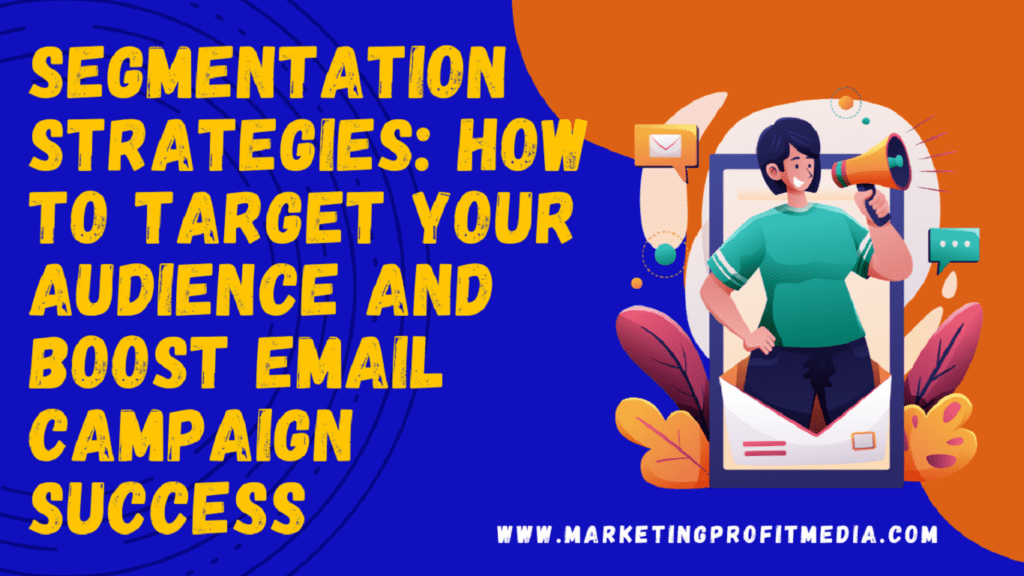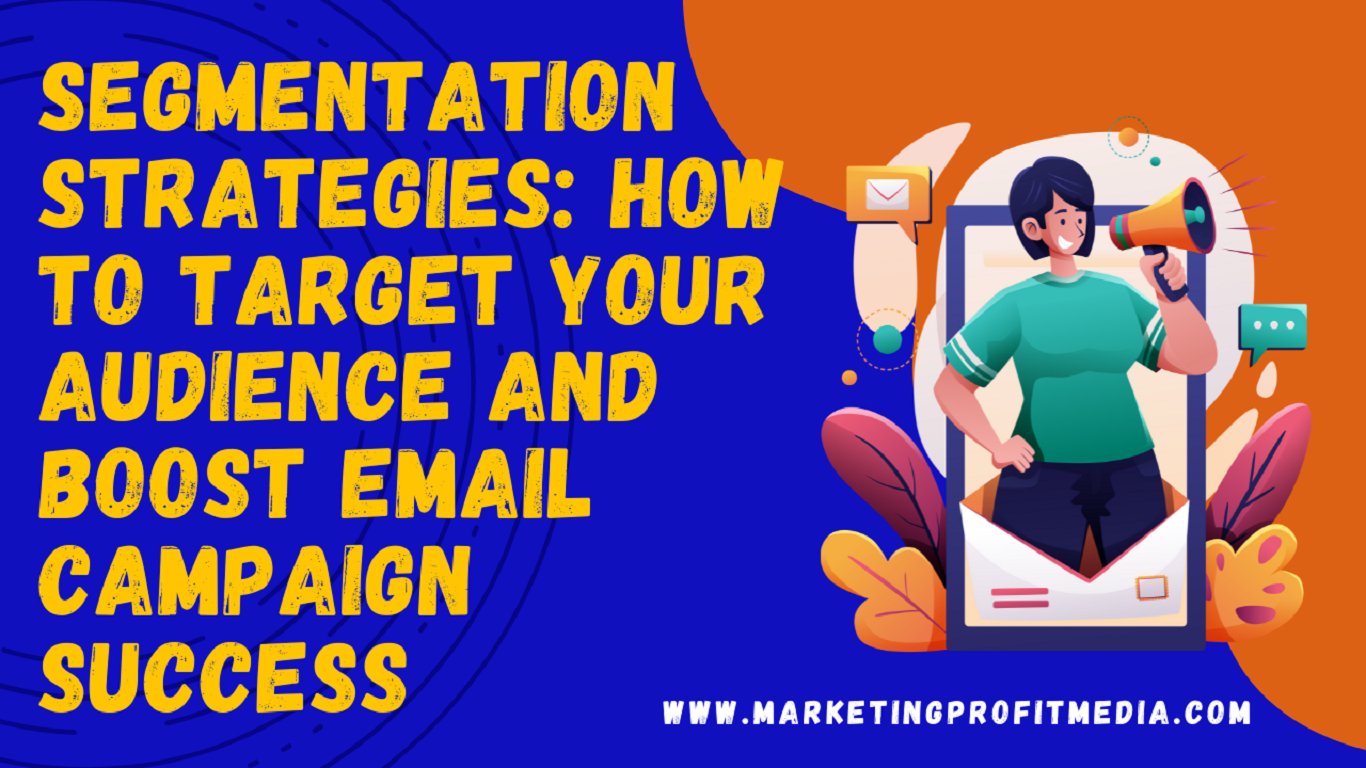Segmentation Strategies: How to Target Your Audience and Boost Email Campaign Success
Welcome to the world of segmentation strategies, where the key to unlocking Email marketing success lies in the careful division of your audience. Imagine being able to send the perfect message to each individual, addressing their unique needs and desires. This is the power of segmentation – a strategic approach that allows you to target your audience with laser-like precision.

In this guide, we’ll delve deep into the intricacies of segmentation strategies and unveil how they can exponentially enhance the effectiveness of your email campaigns. From understanding the diverse types of segmentation to crafting compelling content tailored to each segment, we’ll equip you with the tools to transform your marketing approach. Let’s explore how segmentation can lead to not just emails sent, but emails opened, engaged with, and ultimately, converted from.
My Best Recommended & Proven Way to Make $100 Daily – Watch THIS FREE Training to START >>
1. Why Segmentation Matters
Segmentation isn’t just a choice; it’s a necessity. By tailoring content to specific audience segments, you ignite relevance and connection. Engagement soars, conversions rise, and customer satisfaction grows. In a world of information overload, segmentation is the key to standing out and making a lasting impact.
2. Types of Audience Segmentation
Audience diversity demands targeted approaches. Demographic segmentation categorizes by age, gender, income. Behavioral analyzes actions for tailored recommendations. Psychographic delves into values, lifestyle. Geographic targets local context. Combine these to create powerful, resonant marketing that truly speaks to each audience.
3. Segmentation Strategies for Email Campaigns
Emails that connect are emails that convert. Craft personalized content that speaks directly to recipients’ needs. Send recommendations based on behavior, recover abandoned carts, and celebrate milestones. Segmenting means understanding, engaging, and nurturing your audience for lasting campaign success.
4. Data Collection and Analysis
Unlock the power of segmentation with accurate data. Utilize CRM systems to gather customer insights. Track interactions and purchase history for precise segmentation. Predictive analytics foretell future behavior. Ethical data collection forms the foundation of targeted campaigns that truly resonate and convert.
5. Crafting Compelling Segment-Specific Content
Engage on a personal level with tailored content. Address pain points, using relevant language and imagery that resonate deeply. Boost credibility with testimonials and incorporate personalized recommendations. Your content becomes a conversation that drives connections and conversions within each segment.
6. Automation and A/B Testing
Elevate your email campaigns with efficiency and optimization. Automate workflows for timely, personalized content. A/B testing unveils what resonates best—experiment with subject lines, content, and calls-to-action. Consistent refinement, driven by data, ensures your segmentation strategy evolves into a finely tuned conversion machine.
7. Measuring and Refining Your Strategies
Success thrives on analysis and evolution. Track open, click-through, and conversion rates to gauge segment performance. Adapt based on insights—refine segments and content for optimal results. Continual measurement and adjustment ensure your segmentation strategies stay aligned with audience preferences and campaign goals.
My Best Recommended & Proven Way to Make $100 Daily – Watch THIS FREE Training to START >>
Why Segmentation Matters
Segmentation is not just a marketing technique; it’s the key to unraveling a new level of connection with your audience. By breaking down your audience into distinct segments, you embark on a journey of tailored communication that resonates on a personal level.
- Personalized Relevance: Segmentation empowers you to address your audience’s specific pain points and aspirations. This level of personalization builds trust and engagement, as recipients feel understood and valued.
- Enhanced Engagement: Sending targeted messages eliminates the noise and captures your audience’s attention. This engagement can lead to higher click-through rates, conversions, and overall campaign success.
- Niche Expertise: Segmentation lets you position yourself as an expert in a specific field. By catering to niche interests, you establish authority and credibility within that segment.
- Improved Customer Experience: When your emails align with recipients’ preferences, they perceive a higher level of customer care. This positive experience encourages brand loyalty and word-of-mouth referrals.
In essence, segmentation transforms your marketing efforts from broad strokes to finely tuned interactions, resulting in more meaningful connections and measurable results.
Types of Audience Segmentation
Audience segmentation offers a toolkit for understanding and connecting with your diverse customer base. Here are key types of segmentation that can revolutionize your marketing approach:
- Demographic Segmentation: Divide your audience based on age, gender, income, and more. This allows you to tailor messages to specific life stages and preferences, creating relatable content.
- Behavioral Segmentation: Analyze past interactions to predict future behavior. By understanding customer actions, you can send timely offers, recommendations, and incentives that resonate.
- Psychographic Segmentation: Dive into personalities, values, and lifestyles. Craft messages that deeply resonate with their beliefs, creating a strong emotional connection.
- Geographic Segmentation: Tailor content based on location. Addressing local preferences and needs enhances relevance and engagement.
Each segmentation type provides a unique lens to understand your audience, guiding your efforts towards meaningful connections and impactful campaigns.
Segmentation Strategies for Email Campaigns
Crafting effective email campaigns demands a strategic approach, and segmentation is your secret weapon. Here’s how to leverage segmentation for impactful email marketing:
- Personalizing Email Content: Move beyond just using names. Utilize past interactions to recommend products and content that resonate with each recipient’s preferences.
- Sending Behavior-Based Recommendations: Capitalize on user behavior to send targeted recommendations. Highlight products related to their browsing history, increasing the chances of conversion.
- Retargeting and Abandoned Cart Emails: Re-engage potential customers who’ve abandoned their carts. A well-timed reminder can recover lost sales by reminding them of their interest.
- Event-Triggered Emails: Celebrate milestones like birthdays or anniversaries with personalized emails. This human touch strengthens customer relationships and boosts engagement.
By employing these strategies, you ensure that your emails are more than just a broadcast; they become tailored conversations that drive action and nurture lasting customer relationships.
Data Collection and Analysis
Successful segmentation hinges on accurate data collection and insightful analysis. Here’s how to navigate this crucial aspect of targeted marketing:
- Utilizing Customer Relationship Management (CRM) Systems: Implement CRM systems to gather and organize customer data. This central hub ensures you have a comprehensive view of your audience’s interactions and preferences.
- Tracking User Interactions and Purchase History: Monitor how users engage with your website and note their purchase history. This data provides valuable insights into behavior patterns, enabling more precise segmentation.
- Predictive Analytics: Employ predictive analytics to forecast future behavior based on historical data. This helps in identifying potential leads and customizing content for each segment.
- Privacy and Compliance: Prioritize data privacy and comply with relevant regulations. Ensure transparency and allow users to control their data, building trust and fostering positive relationships.
With robust data collection and insightful analysis, your segmentation strategy gains accuracy, enabling tailored campaigns that resonate with your audience’s preferences and behaviors.
My Best Recommended & Proven Way to Make $100 Daily – Watch THIS FREE Training to START >>
Crafting Compelling Segment-Specific Content
Tailoring your content to each segment is the heart of successful segmentation. Here are key tips to create content that resonates with different audience segments:
- Addressing Pain Points and Needs: Understand the challenges each segment faces and position your products or services as solutions. This relevance sparks engagement and drives action.
- Using Relevant Language and Imagery: Speak your audience’s language. Incorporate imagery that aligns with their experiences and aspirations, creating an emotional connection.
- Incorporating Social Proof and Testimonials: Highlight reviews and testimonials from customers within the same segment. This builds trust and validates your offerings.
- Personalized Recommendations: Suggest products or services based on past behavior. Show your understanding of their preferences, enhancing the likelihood of conversions.
By integrating these strategies, your content transforms from generic messaging to a meaningful dialogue that captivates each segment’s unique interests, leading to increased engagement and higher conversion rates.
Automation and A/B Testing
Efficiency and optimization lie at the heart of successful email campaigns. Here’s how to harness the power of automation and A/B testing to enhance your segmentation strategy:
- Implementing Marketing Automation: Automate workflows to ensure timely and relevant content delivery. This reduces manual efforts, enabling you to focus on strategic planning and analysis.
- A/B Testing for Optimization: Test different content variations within each segment to understand what resonates best. Experiment with subject lines, content, and calls-to-action to fine-tune your messaging.
- Dynamic Content Personalization: Use automation to dynamically insert personalized content based on user behavior or characteristics, providing a seamless and tailored experience.
- Iterative Improvement: Continuously monitor and refine your automation sequences and A/B test results. Small tweaks can lead to significant improvements in engagement and conversion rates.
By embracing automation and A/B testing, your segmentation strategy evolves into a well-oiled machine, delivering content that resonates and consistently drives the best results for your email campaigns.
Measuring and Refining Your Strategies
The success of your segmentation efforts depends on ongoing evaluation and improvement. Here’s how to effectively measure and refine your strategies for optimal results:
- Key Metrics to Track: Monitor metrics like open rates, click-through rates, and conversion rates for each segment. These insights indicate which segments and content types are performing best.
- Adapting Based on Insights: Use collected data to refine your segments and messaging. If a segment isn’t responding as expected, adjust your approach to align with their preferences.
- Segment Performance Comparison: Analyze how different segments are performing against each other. This helps in reallocating resources to the most promising segments.
- Feedback Loop: Encourage customer feedback to gain qualitative insights. This can provide nuanced information that complements quantitative data.
By adopting a data-driven approach and being open to evolution, you ensure that your segmentation strategies remain effective and attuned to the ever-changing dynamics of your audience’s preferences and behaviors.
Conclusion
In summary, Segmentation emerges as the compass leading you to meaningful relationships and demonstrable effect in the ever-changing world of marketing. By targeting certain demographics with well-crafted messages, businesses may generate conversions and boost engagement. The key to segmentation’s effectiveness is realizing that it’s not about getting out to everyone so much as it is about getting through to the appropriate people.
Remember that segmentation isn’t a one-and-done technique; rather, it’s an iterative process of refining and adapting as you go along to improve the performance of your email campaign. You can help your campaigns flourish by keeping an eye on crucial indicators, making adjustments depending on what you learn, and regularly assessing results.
So, take advantage of segmentation in your marketing campaigns. To make an impression that sticks, stimulates relationships, cultivates loyalty, and drives outcomes, you need to craft unique narratives, improve techniques via automation and testing, and assess your efforts.
My Best Recommended & Proven Way to Make $100 Daily – Watch THIS FREE Training to START >>
Thanks for reading my article on “Segmentation Strategies: How to Target Your Audience and Boost Email Campaign Success“, hope it will help!














